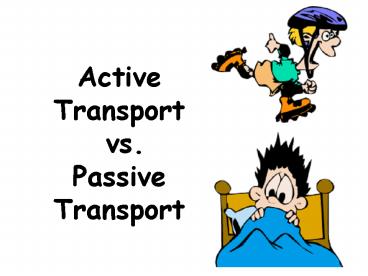Passive Transport - PowerPoint PPT Presentation
Title:
Passive Transport
Description:
Active Transport vs. Passive Transport Passive Transport Goes with the flow with the gradient . HIGH to LOW NO Energy needed Concentration: amount of a ... – PowerPoint PPT presentation
Number of Views:96
Avg rating:3.0/5.0
Title: Passive Transport
1
Active Transport vs. Passive Transport
2
Passive Transport
Goes with the flow with the gradient.
HIGH to LOW
NO Energy needed
3
- Concentration amount of a particular substance
in a given volume - concentration gradient when one area has a higher
concentration than another area does, a exists.
NO!!!! Its too crowded get out!
4
- Equilibrium is a state in which a system remains
unchanged over time. A space is filled evenly,
equilibrium is reached.
A
High to low until equilibrium reached
B
- Passive transport movement across a membrane
without the use of energy (ATP).
5
Modes of Passive Transport
1)Diffusion
Cacaused by temp, pressure, concentration
Only sm particles squeeze through
the diffusion of water through channel proteins
2) Facilitated Diffusion
3) Osmosis
6
Types of Osmotic Solutions
- Isotonic
- Hypotonic
- Hypertonic
7
Isotonic
Same size
Blood Cell
Plant Cell
11,397x
8
Hypotonic
Blood Cell
Plant Cell
13,000x
9
Hypertonic
Blood Cell
Plant Cell
13,000x
10
(No Transcript)
11
- Some unicellular eukaryotes have contractile
vacuoles, which collect excess water inside the
cell and force the water out of the cell. - Animal cells have neither cell walls nor
contractile vacuoles. - Many animal cells can avoid swelling caused by
osmosis by actively removing solutes from the
cytoplasm.
12
Active Transport
Against the gradient.
LOW to HIGH
Requires Energy ATP
13
Modes of Active Transport
- 3 sodium ions go OUT
- 2 Potassium ions go IN
- Is an impt carrier proteins in animal cells
- prevents Na from building up in the cell,
- thus preventing osmosis into the cell.
1)sodium-potassium pump
(Na/K ATPase Pump)
Too big to use carrier proteins use these sacs
- Endocytosis takes stuff IN
- Exocytosis takes stuff OUT
2) vessicles
14
Sodium Potassium pump
15
Endocytosis/Exocytosis
Exocytosis same thingjust EXITS . .er uh
takes it to outside of cell































